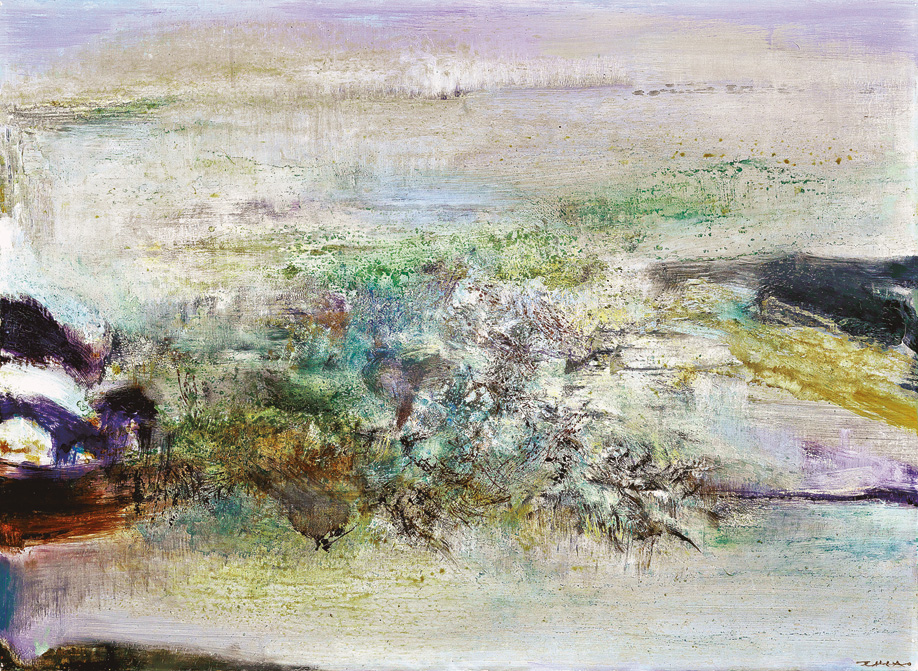The death from illness of Zao Wou-ki's beloved wife May in 1972 left the artist in a state of extreme grief; he was unable to paint for some time afterwards. Eventually, he was able to regain his equilibrium, and took up ink brush painting again, enjoying the familiar feel of ink on paper. This rediscovery of ink brush painting helped to enrich the abstract artistic vocabulary and forms of Zao's later works. The influence of traditional Chinese ink brush painting led to a disappearance of the wild, violent brushstrokes that had characterized some of his earlier paintings. Now, his art was suffused with soft warmth, a sense of boundlessness, and a mysterious, distant spirituality; this became the defining feature of Zao's art in the mid-1970s.
Many art critics consider that, Zao Wou-ki began another art stage after 1973. After he visited relatives and returned from China, his paintings "Regain the creation from ink painting", and his visit obviously had a clear impact on his future work. Zao Wou-ki says in his autobiography: "I know that from 1973 my paintings changed because my friends often told me and especially wrote to me about it. Maybe I had matured, the point where all my experiences came together, where everything became easy, after many efforts and unremitting work? I know for certain that I loved to paint more and more, that I had more and more to express, with constant fear of repeating myself. I painted my own life but I was also searching to paint an invisible place, a dream place, a place where one feels always in harmony, even with faced with contrary forms and agitations." (translated quote from Zao Wou-ki & Françoise Marquet, Zao Wou-ki Autoportrait, éditions Fayard, 1988 pp. 157-158)
During the period 1975 - 1976, Zao Wou-ki's creative imagination grew ever more fertile; he was constantly being invited to stage exhibitions of his work at museums and art galleries. The Palais de Tokyo, the forerunner of the Musée National d'Art Moderne which opened in the Centre d'Art et de Culture George Pompidou in 1977, held a special exhibition of modern art in 1976 prior to the removal of the works in its collections to the new Musée National. One of the rooms in this exhibition - Accrochage III - displayed works by Zao Wou-ki dating from the period 1950 - 1975, reflecting the high status that Zao enjoyed within art circles in France.
The French art historian and critic Dora Vallier has used the concept of "gesture" (in the sense of "action painting") to explore the emotive abstract paintings that Zao Wou-ki produced in the 1970s. She notes the existence of a school of European painters that included Soulage and Hartung who were influenced by East Asian calligraphers, forming part of a trend in which Westerners abandoned the Western artistic tradition and sought to immerse themselves in another culture; over time, increasing familiarity with this other culture undermined the sense of Western superiority. It can safely be assumed that Zao Wou-ki, coming as he did from East Asia and having lived in Paris for several decades, was a major source of inspiration for these artists.
This painting, "25.2.77", was completed in 1977, the year in which Zao Wou-ki met his third wife, Françoise. The gloomy, twisted brushstrokes of Zao's earlier paintings are gone; instead, the painting exudes a light, airy, elegant feel. In discussing his paintings from this period, Zao said that "Each painting, from the smallest to the largest, was part of a kind of dream." (Chaque tableau, du plus petit au plus grand, est toujours un morceau de cet espace de rêve.) The painting has an almost musical appeal; its innovative composition makes effective use of oils to create a neutral tone similar to that of ink brush painting. The lush, harmonious colors leave plenty of space for the viewer's imagination. In this painting, Zao Wou-ki achieves a brilliant presentation of the ideals of traditional Chinese literati painting in modern form, transforming them into something of great value.
